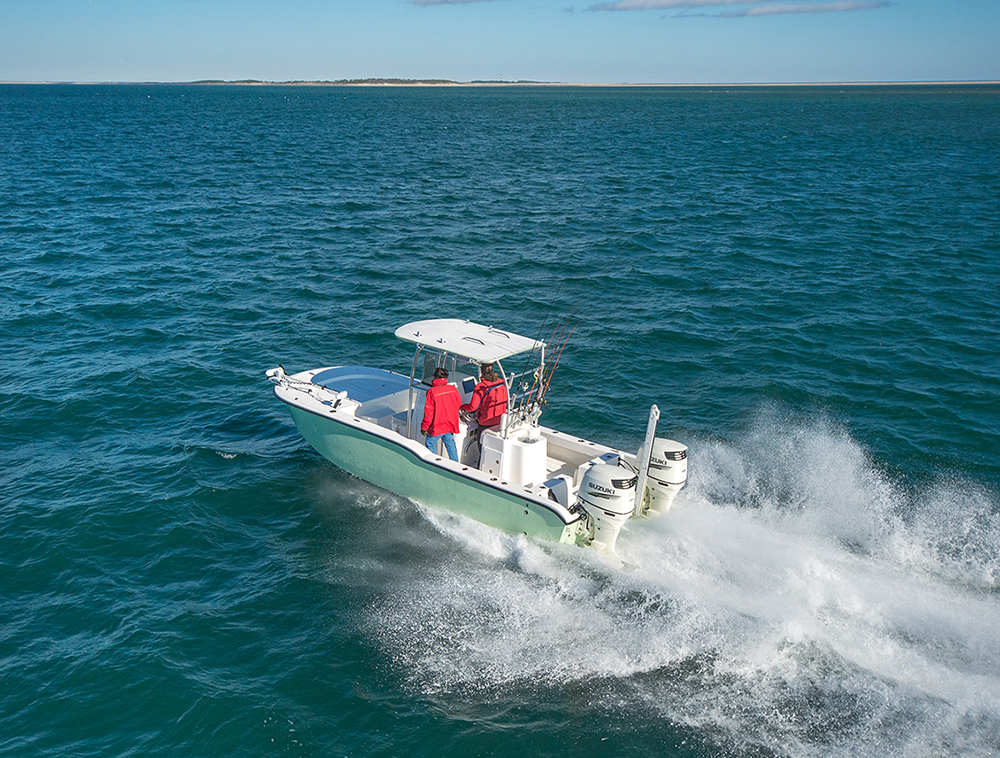If I were buying a new 20-something boat for Chesapeake Bay fishing and runs offshore once in a while, I wouldn’t sign on any dotted lines before giving a close look at the Tideline 235 Hybrid. Now, lest anyone notice that Tidewater is a FishTalk advertiser and think that’s why I’d make such a statement, let me assure you that I’m a monstrous fan of powercats and that’s been true since long before FishTalk even existed. In fact, I’ve personally owned cats for at least two decades now. The one simple reason: I ruined my back in younger years, while pounding across bays and oceans at wide-open throttle in small boats. Today I simply can’t take a pounding like that, and in this one regard, monohulls can’t match up to powercats. That’s not conjecture, but has been numerically demonstrated. Some years ago while working for Boating Magazine, we outfitted pairs of 26 monohulls and 26 powercats with accelerometers to measure the G-forces of impacts when the two boats hit identical waves simultaneously—and the cats delivered 25-percent less impact, on average.

That’s not to say, of course, that cats are “better.” They have down-sides, too, ranging from banking differently in turns, to sneezing (puffing spray out from between the hulls), to snap-rolling. And cats are different from one to the next just as all monohulls are different. So, what makes the Tideline different, in specific? Start with construction. This is one of the only power catamarans of this size and nature which is resin infused. The process in a nutshell: the skin coat gets sprayed in the mold, fiberglass gets put in place, a bag-like layer of plastic with air lines attached goes over the entire hull, and a vacuum pulls vinyl ester resin (the more expensive, less permeable type) through the glass. After the hull and deck are cured they get through-bolted and fiberglassed together. Net result? A rock-solid structure with the ideal glass-to-resin ratio, maximizing strength and minimizing weight.
Another thing that makes the Tideline different is the fact that each 235 is more or less unique. This model began life with the moniker “Bay” but Tideline decided to reintroduce it as the “Hybrid” after eliminating the aft casting deck in favor of an open cockpit. That trades off a bit of shallow water casting aptitude, for more offshore ability. Parents of young fishers will also appreciate having a full cockpit to contain the kids.
This isn’t the only change to consider, however, because Tideline doesn’t build cookie-cutter boats and ship them out to dealerships. Each individual hull is ordered directly through the factory, and the company is happy to semi-customize the boat as an individual owner wants it. That said, the stock boat comes with a 30 gallon livewell in the leaning post, eight rodholders in the gunwales, under-gunwale rodracks, LED lighting, and hydraulic steering with a stainless-steel wheel. It doesn’t make much sense to delve into the available options, because they can basically be whatever you’d like within reason. Towers with upper stations, Power Poles, bow-mount electric trolling motors—you name it. This can, of course, get expensive. Price for the 235 Hybrid pushes into the 100K-plus range depending on which powerplants and options you end up specifying. Performance note: when our sister publication PropTalk ran the 235 it carried a pair of 150-horse outboard, which provided a cruise in the mid-30s and a top-end of 54-mph.
Now, more about that cat ride: here's some footage from when we ran this boat on the Albemarle Sound.
You can see the assessment of the experience in Boiling the Water on a Tideline 235, but it’s probably best to just suggest that you go for for your own sea trial, as we'd always do when checking out a new boat. Because no matter how much we talk about that smooth cat ride and despite seeing it on video, you’ve simply got to experience it for yourself to believe it—and get an accelerometer app for your phone, if you want to see numeric proof.
Tideline 235 Specifications
LOA – 23’5”
Beam – 8’6”
Displacement – 4,900 lbs.
Draft (hull) – 1’2”
Transom deadrise – NA
Fuel Capacity – 120 gal
Max HP – 400
Area Dealers – Contact Tideline directly at tidelineboats.com or (252) 230-8566.
Interested in a bigger, beefier boat? Check out Tideline 365 Offshore Boat Review: Sink Your Claws Into This.